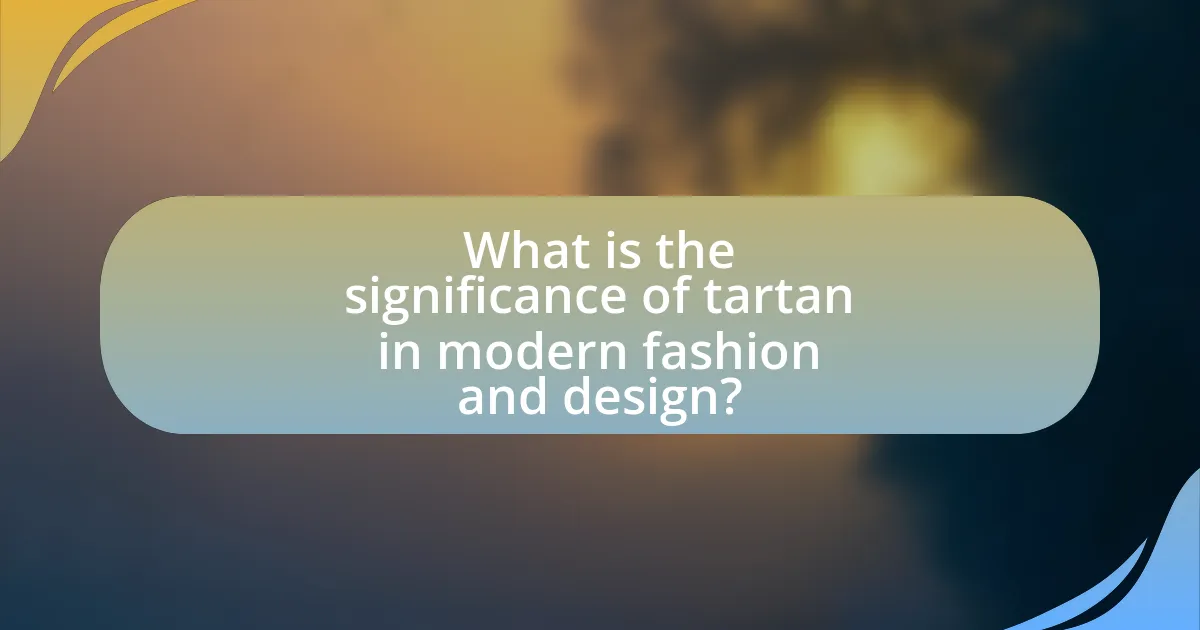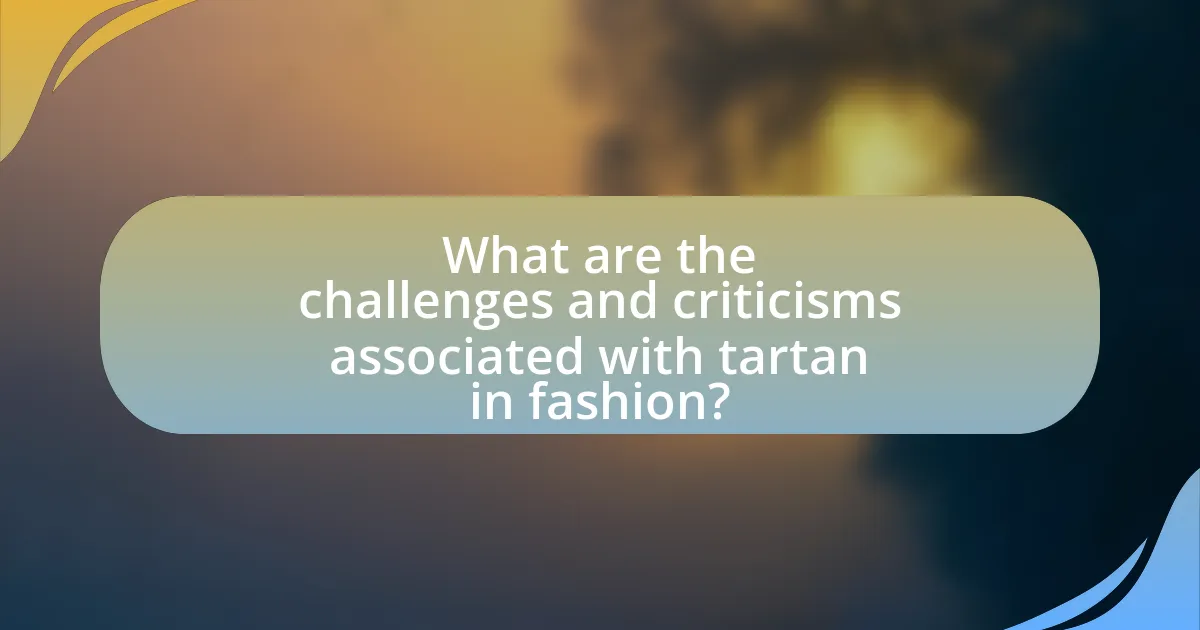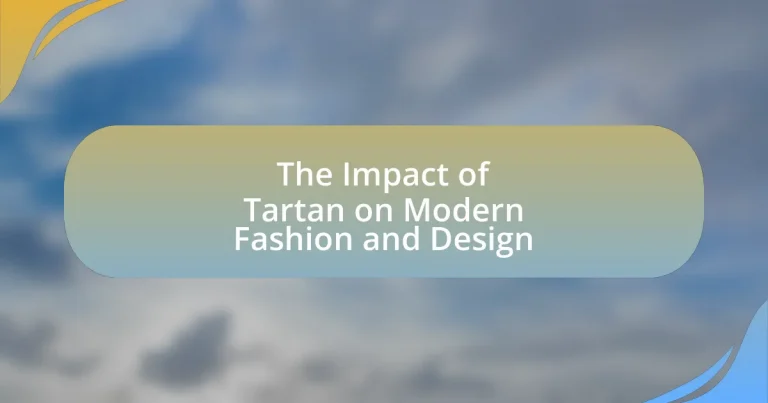Tartan is a significant element in modern fashion and design, symbolizing heritage and cultural identity. Its distinctive patterns are utilized by designers to blend tradition with contemporary aesthetics, as seen in collections from brands like Burberry and Vivienne Westwood. The article explores the evolution of tartan in fashion, its historical influences, and its applications in various design contexts, including clothing, accessories, and interior decor. Additionally, it addresses challenges such as cultural appropriation and sustainability, while highlighting future trends and innovations in tartan fabric technology.

What is the significance of tartan in modern fashion and design?
Tartan holds significant importance in modern fashion and design as a symbol of heritage and cultural identity. Its distinctive patterns and colors are widely utilized by designers to evoke a sense of tradition while also appealing to contemporary aesthetics. For instance, brands like Burberry and Vivienne Westwood have incorporated tartan into their collections, showcasing its versatility and timeless appeal. The resurgence of tartan in streetwear and high fashion reflects its adaptability, with designers often reinterpreting classic patterns to create innovative styles. This blend of historical significance and modern reinterpretation underscores tartan’s enduring relevance in the fashion industry.
How has tartan evolved in contemporary fashion trends?
Tartan has evolved in contemporary fashion trends by transitioning from traditional Scottish heritage to a versatile pattern embraced globally across various styles. Designers now incorporate tartan into streetwear, high fashion, and casual attire, reflecting its adaptability and appeal. For instance, brands like Burberry and Vivienne Westwood have reinterpreted tartan, blending it with modern silhouettes and materials, which has led to its resurgence in popularity. This evolution is evidenced by the increased presence of tartan in seasonal collections and its frequent appearance in fashion weeks worldwide, showcasing its relevance in today’s fashion landscape.
What historical influences shaped the modern perception of tartan?
The modern perception of tartan has been shaped by historical influences such as the Jacobite uprisings, the Romantic movement, and the commercialization of Scottish heritage. The Jacobite uprisings in the 18th century popularized tartan as a symbol of Scottish identity and resistance, particularly through the use of tartan by Scottish Highlanders in battle. The Romantic movement in the 19th century further romanticized Scottish culture, leading to an increased interest in tartan patterns as expressions of national pride. Additionally, the commercialization of tartan in the Victorian era, including its adoption by the British royal family, solidified its status as a fashionable fabric, making it widely recognized and embraced in modern fashion and design.
How do designers incorporate tartan into their collections today?
Designers incorporate tartan into their collections today by blending traditional patterns with contemporary silhouettes and materials. This integration often includes using tartan in various forms, such as prints on dresses, tailored suits, and accessories, which allows for versatility in styling. For instance, brands like Burberry and Vivienne Westwood have successfully modernized tartan by incorporating it into streetwear and high-fashion pieces, demonstrating its adaptability. The resurgence of interest in heritage and sustainable fashion has also led to a renewed focus on tartan, with designers sourcing authentic fabrics and emphasizing craftsmanship, thus reinforcing the cultural significance of tartan in modern design.
Why is tartan considered a timeless pattern in fashion?
Tartan is considered a timeless pattern in fashion due to its rich cultural heritage and versatility in design. Originating from Scotland, tartan patterns have been associated with specific clans and traditions, which adds historical significance and emotional resonance to the fabric. The adaptability of tartan allows it to be incorporated into various styles, from casual wear to high fashion, making it relevant across different fashion eras. Its enduring popularity is evidenced by its frequent appearances on runways and in collections from renowned designers, reinforcing its status as a classic choice in the fashion industry.
What cultural associations does tartan carry in modern design?
Tartan carries strong cultural associations with Scottish heritage and identity in modern design. This distinctive pattern, characterized by its crisscrossed horizontal and vertical bands, symbolizes clan affiliation and national pride, particularly in Scotland. The use of tartan in contemporary fashion and design often evokes a sense of tradition, craftsmanship, and authenticity, linking modern aesthetics to historical narratives. For instance, designers like Vivienne Westwood have incorporated tartan into their collections, reinforcing its status as a symbol of rebellion and individuality while maintaining its cultural roots. The resurgence of tartan in various design contexts, from haute couture to home decor, highlights its versatility and enduring appeal, making it a significant element in the dialogue of modern design.
How does tartan appeal to different demographics in fashion?
Tartan appeals to different demographics in fashion through its versatility and cultural significance. The pattern’s rich history, originating from Scottish heritage, resonates with individuals seeking authenticity and tradition, particularly among those with Celtic roots. Additionally, tartan’s adaptability allows it to be incorporated into various styles, from high fashion to streetwear, attracting younger audiences who appreciate its bold aesthetics. The resurgence of tartan in contemporary collections, as seen in brands like Burberry and Vivienne Westwood, demonstrates its broad appeal across age groups and fashion sensibilities. Furthermore, the global interest in sustainable fashion has led to a renewed appreciation for classic patterns like tartan, as consumers increasingly value timeless designs over fast fashion trends.

What are the various applications of tartan in modern design?
Tartan is utilized in modern design across various applications, including fashion, interior decor, and branding. In fashion, tartan patterns are prominently featured in clothing items such as skirts, jackets, and accessories, reflecting a blend of tradition and contemporary style. Interior design incorporates tartan through textiles like upholstery, curtains, and rugs, adding warmth and character to spaces. Additionally, brands leverage tartan in their logos and packaging to evoke a sense of heritage and authenticity, appealing to consumers’ emotional connections with tradition. The versatility of tartan allows it to adapt to diverse design contexts while maintaining its cultural significance.
How is tartan used in interior design and home decor?
Tartan is used in interior design and home decor primarily as a textile pattern that adds warmth and character to spaces. Designers incorporate tartan through various applications such as upholstery, curtains, and throw pillows, creating a cozy and inviting atmosphere. The versatility of tartan allows it to blend with both traditional and contemporary styles, making it a popular choice for accent pieces and statement furniture. Historical significance also plays a role; tartan patterns are often associated with Scottish heritage, which can evoke a sense of nostalgia and cultural richness in home environments.
What are the most popular tartan patterns for home furnishings?
The most popular tartan patterns for home furnishings include the classic Black Watch, Royal Stewart, and MacLeod tartans. Black Watch, characterized by its dark green and navy blue, is widely used for upholstery and curtains due to its versatility and timeless appeal. Royal Stewart, featuring bright red and green, is often chosen for decorative pillows and throws, adding a vibrant touch to interiors. MacLeod tartan, with its distinctive yellow and black, is favored for its bold aesthetic, making it a popular choice for statement pieces in home decor. These patterns are not only traditional but also reflect a growing trend in modern design, where tartan is embraced for its rich heritage and visual impact.
How does tartan influence color schemes in interior spaces?
Tartan influences color schemes in interior spaces by introducing a rich palette of colors that can harmonize or contrast with other design elements. The distinct patterns of tartan, characterized by their intersecting lines and varied color combinations, provide a visual anchor that can dictate the overall aesthetic of a room. For instance, traditional tartans often feature bold colors like red, green, and blue, which can inspire complementary or analogous color choices in wall paint, furnishings, and accessories. This ability to set a color scheme is supported by the historical use of tartan in Scottish heritage, where specific patterns were associated with particular clans, thus embedding cultural significance into the color choices made in interior design.
In what ways does tartan appear in accessories and lifestyle products?
Tartan appears in accessories and lifestyle products primarily through items such as scarves, bags, hats, and home textiles. These products often feature tartan patterns, which are derived from traditional Scottish designs, reflecting cultural heritage and contemporary fashion trends. For instance, brands like Burberry and Vivienne Westwood incorporate tartan into their collections, showcasing its versatility in both high fashion and everyday items. Additionally, tartan is commonly used in home decor, including cushions, throws, and curtains, emphasizing its adaptability beyond clothing. The enduring popularity of tartan in these products is supported by its historical significance and its ability to evoke a sense of tradition while remaining stylish in modern contexts.
What types of accessories commonly feature tartan designs?
Tartan designs are commonly featured in accessories such as scarves, bags, hats, and ties. These accessories often utilize tartan patterns to evoke a sense of tradition and style, reflecting the historical significance of tartan in Scottish culture. For instance, scarves made from tartan fabric are popular in both casual and formal settings, while bags and hats often incorporate tartan to add a distinctive flair to outfits. Ties featuring tartan patterns are also prevalent, particularly in formal attire, showcasing the versatility of tartan in modern fashion.
How do lifestyle brands utilize tartan in their product lines?
Lifestyle brands utilize tartan in their product lines by incorporating the distinctive plaid patterns into various apparel and accessories, enhancing their aesthetic appeal and cultural significance. Tartan’s historical roots and associations with Scottish heritage make it a popular choice for brands aiming to evoke tradition while appealing to contemporary fashion trends. For instance, brands like Burberry and Vivienne Westwood have successfully integrated tartan into their collections, using it in everything from scarves to outerwear, which not only showcases the fabric’s versatility but also reinforces brand identity linked to heritage and craftsmanship. This strategic use of tartan helps lifestyle brands differentiate themselves in a competitive market while attracting consumers who appreciate both style and cultural narratives.

What are the challenges and criticisms associated with tartan in fashion?
Tartan in fashion faces several challenges and criticisms, primarily related to cultural appropriation, authenticity, and sustainability. Cultural appropriation arises when designers use tartan patterns without acknowledging their Scottish heritage, leading to accusations of disrespecting cultural significance. Authenticity concerns stem from the commercialization of tartan, where mass-produced items dilute the traditional craftsmanship associated with the fabric. Additionally, sustainability issues are highlighted as the fast fashion industry often exploits tartan patterns, contributing to environmental degradation and unethical labor practices. These challenges reflect broader debates within the fashion industry about cultural sensitivity, ethical production, and the preservation of traditional art forms.
How do cultural appropriation issues affect the use of tartan?
Cultural appropriation issues significantly affect the use of tartan by raising concerns about the respectful representation and ownership of this traditional Scottish fabric. The appropriation of tartan by non-Scottish designers and brands can lead to accusations of insensitivity and exploitation, particularly when the cultural significance of tartan is overlooked. For instance, the commercialization of tartan patterns in fashion without acknowledgment of their historical roots can provoke backlash from Scottish communities, who view such actions as a disregard for their heritage. This tension has prompted discussions about the need for cultural sensitivity and ethical practices in fashion, influencing how designers approach the use of tartan in their collections.
What are the perspectives of Scottish heritage advocates on tartan usage?
Scottish heritage advocates generally view tartan usage as a vital expression of cultural identity and tradition. They emphasize that tartan represents historical clan affiliations and serves as a symbol of Scottish pride. Advocates argue that the resurgence of tartan in modern fashion and design can enhance awareness of Scottish heritage, as seen in its incorporation into contemporary clothing lines and accessories. Furthermore, they highlight the importance of respecting the origins and meanings of specific tartans to maintain authenticity and cultural significance. This perspective is supported by the fact that tartan has been recognized as a significant cultural emblem, with its roots tracing back to the 16th century, thus reinforcing its role in both heritage and modern design contexts.
How can designers respectfully incorporate tartan into their work?
Designers can respectfully incorporate tartan into their work by understanding its cultural significance and origins, particularly its association with Scottish heritage. This involves researching the specific tartan patterns and their meanings, as many are linked to particular clans or regions. By honoring these traditions, designers can create pieces that celebrate rather than appropriate the tartan. For instance, using authentic tartan fabrics sourced from reputable Scottish weavers ensures that the designs support local artisans and preserve the craft. Additionally, collaborating with Scottish designers or cultural experts can provide valuable insights, ensuring that the incorporation of tartan is both respectful and informed.
What are the future trends for tartan in fashion and design?
Future trends for tartan in fashion and design indicate a resurgence of traditional patterns integrated with modern aesthetics. Designers are increasingly blending tartan with contemporary silhouettes and sustainable materials, reflecting a shift towards eco-conscious fashion. For instance, brands like Burberry and Vivienne Westwood have been reinterpreting tartan in innovative ways, showcasing its versatility in both casual and high-fashion contexts. Additionally, the rise of digital fashion and virtual reality is allowing for experimental uses of tartan patterns, enabling designers to push boundaries beyond physical limitations. This evolution is supported by consumer interest in heritage and authenticity, driving demand for tartan in diverse applications, from streetwear to luxury collections.
How might sustainability influence the use of tartan in the future?
Sustainability is likely to significantly influence the use of tartan in the future by promoting the adoption of eco-friendly materials and production methods. As consumers increasingly prioritize sustainable fashion, designers may shift towards using organic fibers, recycled materials, and low-impact dyes in tartan textiles. This transition aligns with the global trend towards reducing environmental impact, as evidenced by the Sustainable Apparel Coalition’s Higg Index, which emphasizes the importance of sustainable practices in the fashion industry. Consequently, the future of tartan may see a blend of traditional patterns with innovative, sustainable practices, enhancing its relevance in modern fashion while addressing ecological concerns.
What innovations are emerging in tartan fabric technology?
Innovations in tartan fabric technology include the development of smart textiles that incorporate sensors for temperature regulation and moisture-wicking properties. These advancements enhance the functionality of tartan fabrics, making them suitable for both traditional and modern applications. For instance, companies are now integrating nanotechnology to create stain-resistant and durable tartan materials, which significantly improve their longevity and ease of care. Additionally, advancements in digital printing technology allow for more intricate and customizable tartan patterns, catering to contemporary fashion trends while preserving the cultural significance of tartan designs.
What practical tips can designers follow when using tartan in their work?
Designers can enhance their work with tartan by considering scale, color combinations, and cultural significance. Using large-scale tartan patterns can create bold statements, while smaller patterns may be more suitable for subtle accents. Additionally, pairing tartan with solid colors or complementary patterns can prevent visual clutter and maintain balance in designs. Understanding the cultural heritage of tartan, which dates back to Scottish clans, allows designers to respect its origins and use it thoughtfully, ensuring authenticity in their creations. This approach not only elevates the aesthetic appeal but also honors the historical context of tartan in fashion and design.





